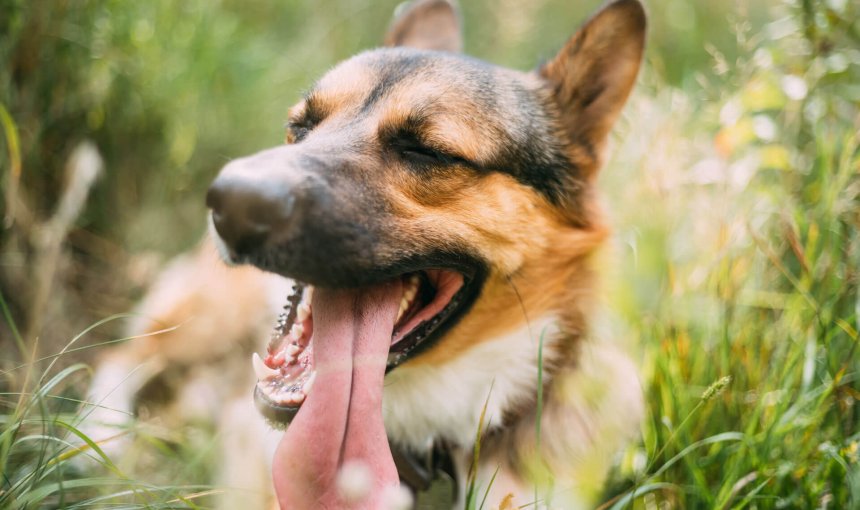 Approved by Dr. Dwight Alleyne, DVM
Approved by Dr. Dwight Alleyne, DVM Heat Stroke In Dogs: How To Spot It Early & What To Do
Get the top tips for preventing and handling heat stroke in dogs here to keep your furry friend safe, always!

As the warm days approach, you and your dog might end up spending more time outdoors. But watch out: there’s always the risk they might pick up a bad case of heat stress, heat exhaustion, or even heat stroke in dogs. (Which could be fatal if you don’t pick up on the signs.) So here’s to spot it early – and how to tell if your buddy’s been spending too much time outdoors – so you two can enjoy the summer days ahead!
Key Takeaways
🥵 Heat stroke is a life-threatening condition for dogs that can develop quickly in hot, humid weather or after intense activity.
🐶 Warning signs include excessive panting, drooling, lethargy, vomiting, uncoordinated movements, and collapse.
🫗 Move your dog to a cooler area, offer water, and cool them with damp towels – then head over to your vet right away.
🚗 Avoid walking dogs during peak heat, never leave them in cars, and ensure they always have shade and water.
🌎 A smart dog tracker (like Tractive) can help you pick up on the signs of heat stroke in dogs – like excessive panting or an elevated heartbeat.

Always know your buddy is healthy & safe
Read moreWhat is heat stroke in dogs?
Unlike humans who eliminate heat through sweating, dogs pant to cool themselves down and regulate their body temperature. But in some cases panting is not enough. As a dog’s body temperature rises, so does their likelihood of experiencing a heat-related illness. Heat stroke is most common in the warm months, but can happen to your dog any time of year. It can also happen quite suddenly, so it’s important to know what to look out for.
Hyperthermia in dogs occurs when panting is not enough – and their body temperature increases above 39°C. They’re then at risk for a whole bunch of heat-related illnesses, including heat stroke in dogs.
When dogs experience heat stress, they become very thirsty and pant rapidly. The dog is mentally aware and can move about, but is under stress from the heat. It’s important to cool them down immediately at this stage, to prevent heat exhaustion or heat stroke.
Heat stroke vs heat exhaustion in dogs
| Heat stroke in dogs | Heat exhaustion in dogs |
| Heat stroke is the most serious form of hyperthermia, in which the dog’s temperature reaches a dangerous 41.1°C or even higher. Neurological and organ function begins to fail. At 43°C, proteins which make up the cells of the dog’s body begin to melt. The higher the temperatures and the longer the dog is exposed to heat, the greater the chances are of organ failure and death1. | In cases of heat exhaustion, the heat stress has become extreme. The heat-exhausted dog typically is very weak and may have difficulty moving around and could collapse. They are very thirsty, and pant heavily. |
Can dogs die of heat stroke?
Yes, heat stroke in dogs can cause death. High temperatures affect various organ functioning and cellular structure, and can cause a dog’s body to shut down irreversibly. So it’s important to be aware of the warning signs of overheating and heat stroke in dogs and take steps to cool your dog down in hot weather conditions.
💡Worried your dog might be spending too much time outdoors – or out of sight? A smart dog tracker with real-time GPS tracking can help you figure out if they’ve been hanging out in the “hot spots” near you. Else, if it’s hot outdoors and you don’t know where they are, you can check their location in real-time, with just a glance at your phone.

Follow your dog anywhere
Get real-time location information, wherever they go. And find out when they try to make an escape, or just when they go somewhere they shouldn’t, with Virtual Fences.
What causes heat stroke in dogs?
- Being left outside without shade or water on a hot day
- Vigorous exercise in hot weather
- Confinement inside a poorly ventilated area, like a dog house
- The restricted airways of ‘smashed’ or flat-faced dogs – brachycephalic breeds are more likely to experience heat stroke even in moderate weather conditions
- Long haired dog breeds are also more likely to face heat stroke
- Wearing a muzzle
- Infection causing fever2
- Obesity
- Young and old age in dogs
Signs and symptoms of heat stroke in dogs
- Panting
- Drooling
- Increased thirst
- Dehydration
- Weakness, falling down
- Dizziness
- Confusion
- Hyperventilating
- Dry nose
- Rapid or irregular heart rate
- Diarrhea
- Vomiting
- Elevated body temperature – warm to touch
- Dry, pale gums
- Bright red tongue
- Thick, sticky saliva
- Changes in mental awareness
- Production of only small amounts of urine or no urine
- Blood in vomit or stool
- Staggering
- Muscle tremors
- Shock
- Seizures
- Stoppage of the heart and breathing
- Coma
- Death3
What to do if your dog gets heat stroke
If your dog gets heat stroke, it’s important to bring down their temperature immediately, but safely. Do NOT cool the dog down using ice cold water. Going from one extreme temperature to another can cause other life-threatening medical conditions. If your dog suffers from a heat stroke, here’s how you can help them cool down:
- Remove them from the hot area immediately.
- If your dog is still conscious, let them drink as much cool water as possible. Adding a bit of salt to the water will help the dog replace the minerals it lost through panting. If the dog is unconscious, however, make sure no water enters the nose or mouth.
- Wet them with water, put them in the bath or shower if possible.
- Use a fan to increase air circulation around them and cool them off.
- Lay a wet towel on them.
- After cooling down your dog, call your vet or an emergency clinic, and take your pet there as quickly and safely as possible.
- While transporting your dog to the vet, continue lowering their temperature by placing cool, wet towels over the back of their neck.
- Keep the body temperature around 38.3°C to 39.2°C4 and stop the cooling when the right temperature is reached.
Even if your dog appears to be recovering from heat stroke, you should still bring them to the vet, since they may be dehydrated or have other complications.
What can I expect at the vet?
In all cases of heat stroke in dogs, including suspected cases, and dogs who seem recovered, you should see your vet immediately. Your vet will be able to determine the severity of your dog’s condition and what kind of treatment is necessary. They might administer:
- Emergency cooling
- Intravenous fluids
- Oxygen therapy
- Airway intubation
- Gastrointestinal protectants, anti-nausea medication
- Antibiotics
- Pain medication
- Cardiac medication
- Blood tests
- Blood/plasma transfusion
- Ventilation
- Continuous observation and treatment, often in the intensive care unit3
At the same time, we do want to emphasize:
The best way to deal with heat stroke in dogs is to prevent it from happening in the first place.
How to prevent heat stroke in dogs
- Never leave your dog in a car with the windows closed
Even for “just a minute” or even if the car is parked in the shade. The temperature inside a parked car can quickly get extremely high. In fact, don’t leave your dog inside any hot, enclosed space. If you travel with your dog in the car, make sure that your dog is well ventilated by placing them in a wired cage or an open basket. Keep the car cool, stop frequently and make sure water is available. - Avoid exercising with your dog during the hottest time of day
Limit outdoor activities to the early morning and late evening, when temperatures are lower. - Provide your dog access to plenty of cool water
And make sure they stay hydrated. Find out how much water your dog needs to drink in a day here. - Provide your dog access to shade
To help them cool down, no matter where you are. Try and avoid going on walks with the sun directly overhead. Likewise, avoid walking on any surfaces where heat is reflected (such as hot sand or concrete).
Where a smart dog tracker can help
When temperatures rise, it’s more important than ever to keep a close eye on your dog’s activity, behavior, and whereabouts. That’s where a smart tracker for dogs – like the Tractive GPS – can be a potential lifesaver.

Strapped to your dog’s collar or harness, here’s how your trusty Tractive device can help prevent heat stroke and ensure you can:
- Track your dog in real-time
Switch on LIVE mode to see your dog’s exact location at all times, so you can react fast if they run off or get lost in the heat. - Understand where your dog’s been spending their time
From their Heat Map and Location History. Including how long they’ve spent in the sun and exactly where – so you can prevent them from venturing there next time. - Get alerted if your dog ends up in a “no-go” zone
From your app, you can set up “safe zones” (like shady backyards) and get escape alerts if your dog leaves them. This can help you intervene before they wander into hotter or unsafe areas.


- Catch on to the signs of heat stress quicker
With its built-in motion detector, your trusty Tractive device also monitors your dog’s exercise levels and rest time. If there’s a weird drop in your dog’s active minutes – potentially because of heat stress or exhaustion – you’ll get notified via a Health Alert. So you can take action quicker and get them to a vet right away. - Monitor your dog’s vital signs
Via your tracker’s Health Monitoring features, which keep an eye on your dog’s respiratory rate and even heart rate. So if your dog seems to be panting more than usual – which may be an early sign of heat stroke – you’ll know that much quicker.
With the help of a smart tracker like Tractive, you can stay one step ahead and take quick action – potentially preventing a dangerous situation before it gets worse.
And if you’ve liked this post, share it with a friend or a loved one – and let’s help build a safer, kinder world for our furry friends together.
Your furry friend’s health and wellbeing means as much as to us as it does to you. So we’ve made it a priority to only share medically-relevant content on our blog. This post was checked, double-checked, and medically verified by Georgia-based vet, Dr. Dwight Alleyne.

Dr. Dwight Alleyne, DVM
Originally from Long Island, New York, Dr. Alleyne began his career at a no-kill animal shelter before becoming a licensed veterinary technician. He graduated from Cornell University Veterinary College in 2006 and completed an internship at Purdue University. Now practicing in Georgia, Dr. Alleyne specializes in soft tissue surgery and ultrasounds. He also writes pet health articles on his website, “The Animal Doctor Blog” (www.anmldrblog.com).



